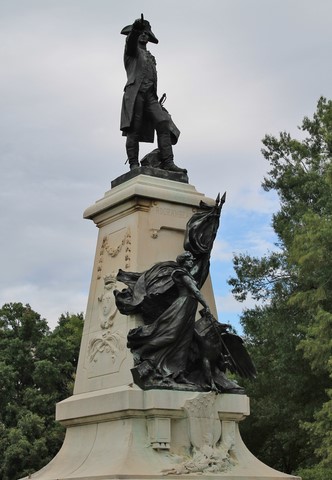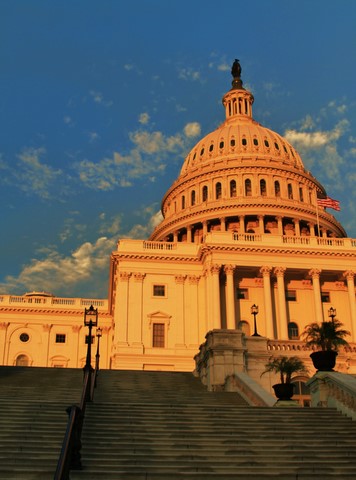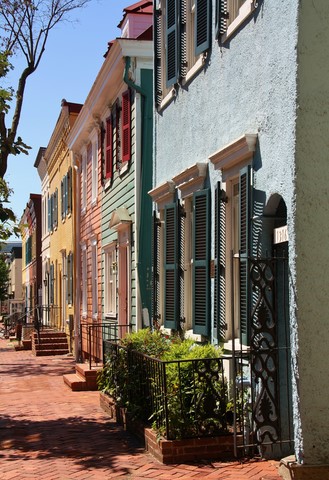Washington DC
You can click on pictures to enlarge them
The paradox of the American capital is that it is not representative of typical American cities with their usual skyline that you can see from the distance. It is very airy and it has no skyscrapers. During our stay, we saw two diametrically opposite aspects of it: first, the must-see and high-publicized institutional Washington, embodied by buildings that are famous all around the world like the White House and the US Capitol, but also by pharaonic memorials, disproportionate lawns, gardens and watercourses. As for the Smithsonian prestigious museums, they are part of the biggest museums and art galleries ensembles in the world, supplemented by zoological gardens and research departments. Then, we discovered the historic Washington, more human, more colored, lively thanks to the student life in some areas. We ignored that aspect and it turned out to be a real surprise. We left DC with a much different idea to the picture we had in our minds through the distorting mirror of medias.
West of the National Mall & White House
The National Mall is a huge 3 kilometers long rectangle that starts at the Potomac River and ends just before the US Capitol. We started the visit with the Lincoln Memorial, where a more than 5 meters high statue of Abraham Lincoln in a temple is surrounded by imposing Doric columns. There are 36 of them, like the number of states at the time. That is where Martin Luther King held his famous speech «I have a dream» in 1963. It stands in front of the Reflecting Pool, 500 meters long basin that leads straight to the World War II Memorial. The visit of the latter was planned for later, so we carried on with the Korean War Veterans Memorial, where you can see soldiers patrolling with their faces hollowed out because of efforts and tiredness. Then, we went to admire the Dr. Martin Luther King, Jr. Memorial, inaugurated by President Barack Obama in 2011, where a colossal granite statue of the spokesman of the Afro-Americans Civil Rights Movement proudly rises. It is located by the Tidal Basin, artificial basin lined with Japanese cherry-trees, which spectacular blossoming is celebrated in early spring during the National Cherry Blossom Festival. The Franklin Delano Roosevelt Memorial shows the former president in many different aspects according to his four terms. You can notably see him sitting on a bench with his dog at his feet. Some of his most famous quotations are engraved in large letters on the walls that separate the different parts of the memorial. Not far stands a statue of its wife Eleanor. The George Mason Memorial pays tribute to one of the Founding Fathers, resolutely abolitionist. He is represented there sitting in deep thought. Also by the Tidal Basin, the Thomas Jefferson Memorial is a huge stone rotunda composed of Ionic columns and a dome that houses a 6 meters high bronze statue of the president.
Then, we walked to the Washington Monument, a 168 meters high white marble obelisk erected in the center of the National Mall in the late 19th century, into alignment with the Lincoln Memorial to the West and the US Capitol to the East. As the name suggests, it pays tribute to the country’s first president. It has an observation platform. It is surrounded by 56 American flags: 50 for each state, and 6 for the American territories around the world. The World War II Memorial is a wide perfectly symmetric architectural ensemble. On each side rises a triumphal arch adorned with superb sculptures: one is dedicated to the Atlantic Veterans, the other to the Pacific Veterans. They are located on each end of a wide oval, along which 56 big granite rectangular columns covered with a bronze crown run along. Each one stands for a state, a territory or an American district that participated in the war.
The Vietnam Veterans Memorial surprises with its totally sober style that contrasts with the other memorials. There is nothing Pharaonic: no architectural refinement, no statue, no column and no fountain. It is just made of two huge polished black granite walls that come together forming a V in a very wide angle. The names and first names of the too numerous victims are engraved in golden letters. That troubling sobriety is just what deeply made a big impression on us: it is the reflection of the trauma generated by that war that quickly became unpopular, but in which the successive governments got fiercely bogged down. That memorial totally stands out from the others and it may be the intended effect. Only some flowers put down by private individuals provide their share of colors, but it is not enough to forget the dread and the unease generated by the mere mention of that disastrous war. Two elements were added to it: Three Servicemen, bronze sculpture of three men in uniform: a Hispanic, a white man and an Afro-American. As for the Vietnam Women’s Memorial, it is dedicated to the women who served in the war, most of them as nurses. It is another bronze sculpture that depicts Hope, Faith and Charity, three women in uniform, one of them holding an injured soldier in her arms.
Then we went to admire the White House. We started with its Southern façade and its famous semicircle-shaped portico with columns known all around the world. Of course, the site was highly secure, so we had to be content with contemplating that beautiful Georgian manor from the late 18th century from the distance. We stayed there for several minutes, and then we took the 17th Street on the left side. We notably passed in front of the Eisenhower Executive Office Building, massive Second Empire style building. Built in the late 19th century, it includes more than 500 rooms and it is home to the Friends of the American President’s headquarters. Nearby, the Renwick Gallery of the Smithsonian American Art - also in Second Empire style - houses arts and crafts and decorative arts works from every era during temporary exhibitions. Finally, we went in front of the main entrance of the White House. On the other side of Pennsylvania Avenue stands the nice garden Lafayette Square (photo), in the middle of which rises a statue of General Andrew Jackson on his horse surrounded by four cannons. Statues of foreign heroes of the Independence War were erected on every corner of the park. We lingered there as well, and then we went back to the National Mall after we looked up to admire the small clock on the rounded corner of the roof of the Suntrust Bank Building, as well as the nice earthenware decorations around it.
East of the National Mall & US Capitol
We passed again close to the Washington Monument that the late afternoon light peeking through the clouds covered with nice warm colors. After a gloomy day, the sun started to appear at last, which promised a beautiful end of day. The American flags around the building were tight in parallel due to a pleasant wind. We turned left to head for the US Capitol in order to visit the other half of the National Mall, where superb museums run along. We admired the Smithsonian Institution Building, sumptuous red sandstone building nicknamed «The Castle»: in Medieval Renaissance style, it proudly displays its crenelated towers. It houses administrative services and the information center of the Smithsonian. Nearby stands the splendid and colored Arts and Industries Building, also made of red sandstone. In Victorian style, it has some aspects of Moorish style as well. It is home to beautiful collections of pieces from Victorian America.
Then, we got closer to the US Capitol, making a stop to admire the Ulysse S. Grant Memorial, erected for that Commander in Chief of the Union Army during the American Civil War, and president of the U.S.A., represented there on his horse. It is one of the biggest bronze statues in the world. In front of it stretches an area of water: the Capitol Reflecting Pool. Finally, we got as close as possible to the US Capitol (photo), highly secure site. We were surprised to learn that we were facing the back of the building: indeed, they thought at the time of its construction that the city would extend to the East, but the contrary happened. So, that famous building that draws crowds from all around the world turns back to the National Mall. Located in the intersection of the four main districts of Washington, it is the hub of the city. Its construction started in the late 18th century. It was covered with a dome in 1866. That beautiful and colossal rotunda is extended by a wing on each side, the whole in a perfect symmetry. Its architecture is very rich and much refined. Its frescoes and its bronzes are remarkable. It houses the Senate Chamber. We were lucky to admire it under extraordinary climate conditions: it was taking on superb colors thanks to a low sun topped by clouds that were set ablaze in its light. Opposite, the National Mall shone under the bright warm colors that shimmered on the Reflecting Pool. So, we decided to contemplate that beautiful spectacle until dusk; we already knew it would be part of the highlights of that extraordinary trip.
Georgetown
It is the iconic district of Washington. It was originally a tobacco port. Founded in the late 18th century, it displays nice paved streets and charming brick or colored wood houses. Some of them – row houses – have the characteristic of being similar and aligned, only distinguished by their colors (photo). Many streets are wooded, and lingering there is very pleasant. We took a long walk there the day after we discover the National Mall and the weather was beautiful. We took the car because Georgetown is not connected by the subway, in order to preserve its beauty and its authenticity. Arts galleries are numerous. Its shopping streets, where very varied boutiques, fancy restaurants and trendy bars abound, are very prized at night - especially by students - and for the weekend.
The C & O Canal was used to transport goods along the Potomac River to Maryland or from that same state. Now, all that is left is a pleasant shaded waterway where you can be tempted by a picturesque boat ride, dragged by a mule. Old Stone House is the oldest house in Washington, and the only in the area that preserved its Post-Revolution aspect, in the best tradition of stone houses built by settlers. Christ Church had various architectural styles since its construction in the early 19th century: first Georgian, then Victorian, and finally Gothic Revival. The Federal style house Dumbarton Oaks houses a museum with sumptuous collections of Byzantine and Pre-Columbian art. It is surrounded by an idyllic green area composed of terrace gardens and numerous ponds. The Dumbarton House, built in the late 18th century on the heights, houses nice collections of paintings and furniture from the 17th, 18th and 19th centuries. Oak Hill Cemetery extends over a very pleasant wooded and undulating area. Its chapel is in Gothic Revival style.
We went to see the Exorcist Steps, which visit was some kind of cinematographic pilgrimage: indeed, one of the scenes of the famous movie «The exorcist» was shot on that narrow and steep stairway, when one of the priests finds brutally dead in mysterious circumstances after he tried to exorcise the possessed young girl. Then, we carried on to Georgetown University, where notably the former president Bill Clinton studied. Founded in the late 18th century by the Potomac River and owned by Jesuits, it is the oldest Catholic university in the U.S.A. Scenes from «The exorcist» were also shot there. It is Gothic Revival style and its chapel enjoys beautiful stained-glass windows. The colossal buildings proudly rise in front of verdant and shaded lawns. As in the University of Toronto, I was surprised by the liveliness of that place in high summer: students – or future students – were visiting the campus with their parents. We could feel a certain pride in each of them: the students for their integration in such a prestigious establishment and the parents for their children’s achievement. That told us about the world of difference between American universities and French universities.
Published on January, 4th 2019






